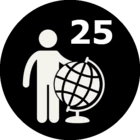The tolerance in TINGenerator does not seem to do anything? I have a workspace where a geotiff gets converted to a pointcloud for some processing before running through a TINGenerator. I have tried values between 1 and 1000 but it always outputs the same amount of VertexPoints. Only thing that makes any difference is if I set the value to 0, then the amount of vertexpoints get multiplied by a million. In the same workspace I also use a PointCloudCombiner. Where the value of the point interval does not seem to make any difference.
Does the workspace need to be set up in a specific way in order for the above to work? Or have I just missunderstood what the values are supposed to do?






